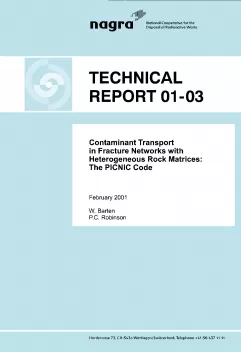
Technical Report NTB 01-03
Contaminant Transport in Fracture Networks with Heterogeneous Rock Matrices: The PICNIC Code
In the context of safety assessment of radioactive waste repositories, complex radionuclide transport models covering key safety-relevant processes play a major role. In recent Swiss safety assessments, such as Kristallin-I, an important drawback was the limitation in geosphere modelling capability to account for geosphere heterogeneities. In marked contrast to this limitation in modelling capabilities, great effort has been put into investigating the heterogeneity of the geosphere as it impacts on hydrology. Structural geological methods have been used to look at the geometry of the flowpaths on a small scale and the diffusion and sorption properties of different rock materials have been investigated. This huge amount of information could however be only partially applied in geosphere transport modelling.
To make use of these investigations the "PICNIC project" was established as a joint cooperation of PSI/Nagra and QuantiSci to provide a new geosphere transport model for Swiss safety assessment of radioactive waste repositories. The new transport code, PICNIC, can treat all processes considered in the older geosphere model RANCHMD generally used in the Kristallin-I study and, in addition, explicitly accounts for the heterogeneity of the geosphere on different spatial scales.
The effects and transport phenomena that can be accounted for by PICNIC are a combination of (advective) macro-dispersion due to transport in a network of conduits (legs), micro-dispersion in single legs, one-dimensional or two-dimensional matrix diffusion into a wide range of homogeneous and heterogeneous rock matrix geometries, linear sorption of nuclides in the flowpath and the rock matrix and radioactive decay and ingrowth in the case of nuclide chains. Analytical and numerical Laplace transformation methods are integrated in a newly developed hierarchical linear response concept to efficiently account for the transport mechanisms considered which typically act on extremely different timescales. To account for one-dimensional matrix diffusion into homogeneous planar or cylindrical rock layers, analytical relations in the Laplace domain are used. To deal with one-dimensional or two-dimensional matrix diffusion into heterogeneous rock matrices, a finite-element method is embedded. The capability of the code for handling twodimensional matrix diffusion is – to our knowledge – unique in fracture network modelling.
To ensure the reliability of the code, which merges methods from graph theory, Laplace transformation, finite-element methods, analytical and algebraic transformations and a convolution to calculate complex radionuclide transport processes over a large and diverse application range, implementation of the code and careful verification have been alternated for iterative improvement and especially the elimination of bugs. The internal mathematical structure of PICNIC forms the basis of the verification strategy.
The code is verified in a series of seven steps with increasing complexity of the rock matrix. Calculations for single nuclides and nuclide decay chains are carefully tested and analysed for radionuclide transport in single legs, in pathways and in networks. Different sources and boundary conditions are considered. Quantitative estimates of the accuracy of the code are derived from comparisons with analytical solutions, cross-comparisons with other codes and different types of self-consistency tests, including extended testing of different refinements of the embedded finiteelement method for different rock matrix geometries. The geosphere barrier efficiency is a good single indicator of the code accuracy. Application ranges with reduced accuracy of the code are also considered.
For one-dimensional matrix diffusion into homogeneous and heterogeneous rock matrices, crosscomparisons with other codes are performed. For two-dimensional matrix diffusion, however, no code for cross-comparison is available. Consequently, the verification for these geometries relies chiefly on the verification for one-dimensional matrix diffusion, on qualitative estimates and on different self-consistency tests. The steady-state release for a single nuclide is additionally verified quantitatively.
PICNIC has been verified as far as possible at present to allow application with confidence in performance assessment and in modelling of transport experiments. It is shown that structural geological information on small-scale heterogeneity can be entered easily into PICNIC. It is explained, e.g. that considering two-dimensional matrix diffusion into the layer of altered wallrock adjacent to open channels in the cataclastic zone can strongly increase the performance of the geosphere for migrating radionuclides, depending however on the properties of the nuclides and the rock. Considering the effects of matrix diffusion into a second rock layer can also be highly beneficial.
